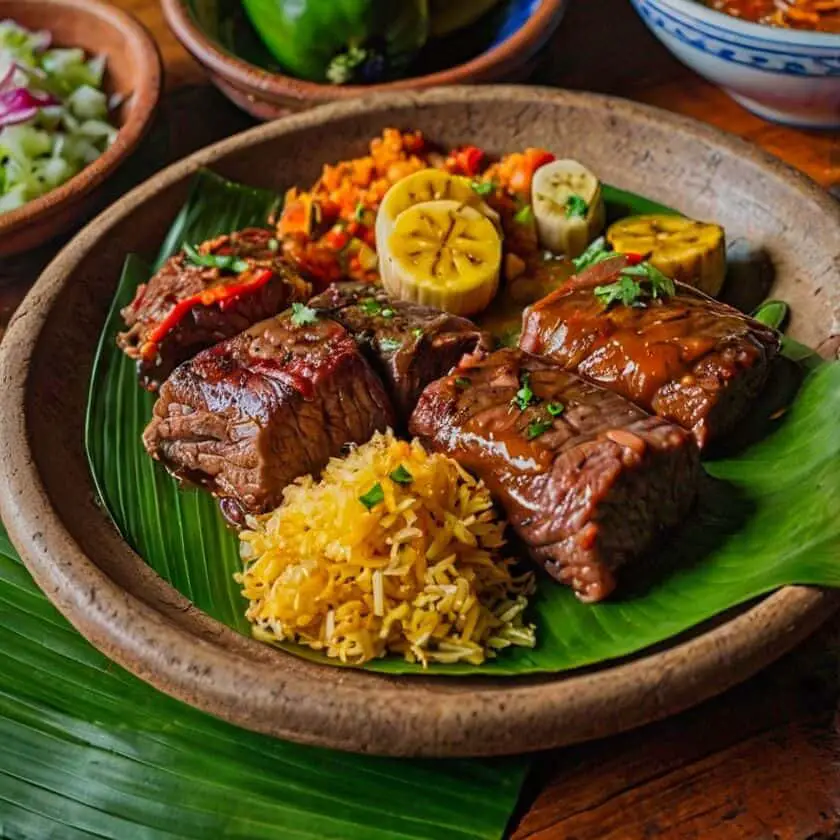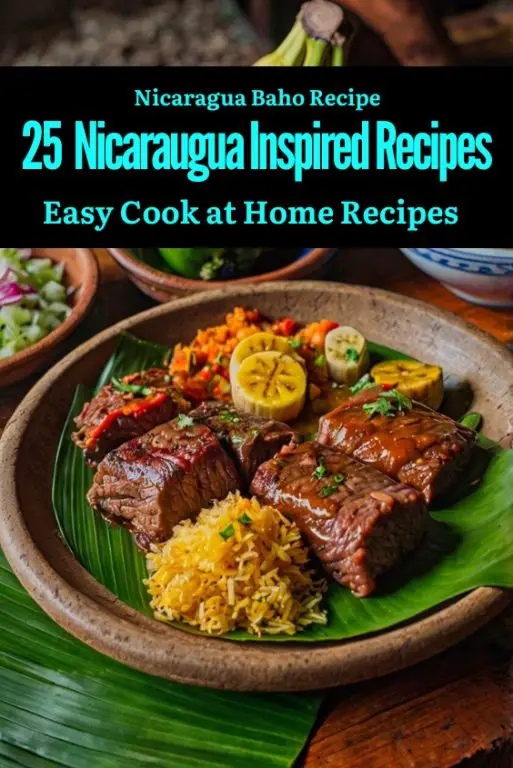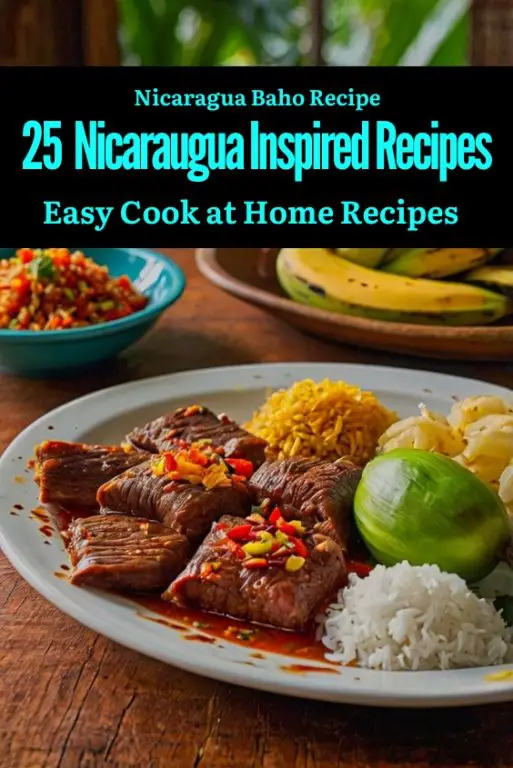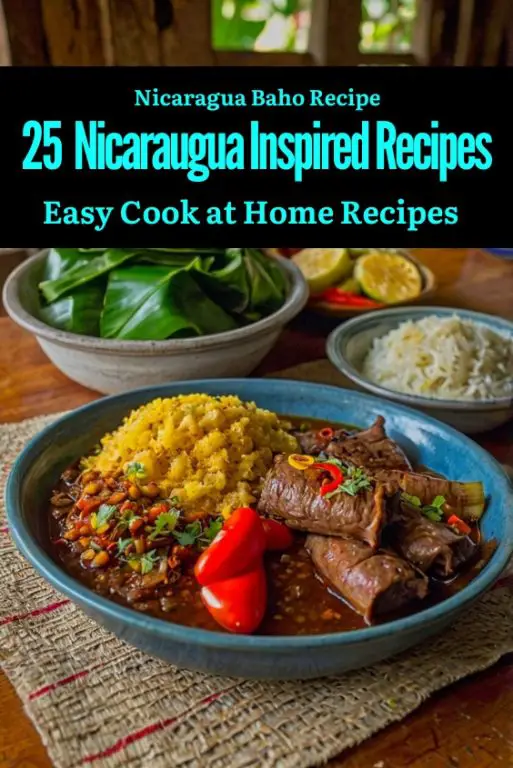Food like the Nicaraguan Baho recipe can be a journey into culture for me. Known for its hearty flavors and textures, Baho – or vaho – as it is sometimes called – is a Sunday afternoon meal. It is unique in that beef brisket, green and ripe plantains, and yuca are wrapped in banana leaves and steamed to perfection.
When I make Baho I start the process the day before by marinating the meat overnight. This step is essential to provide the beef a tasty increase of tomatoes, orange juice, garlic, onions, green peppers, salt and lime juice. The marinade has penetrated the meat a bit more the next day, and so each bite is succulent. In case you want going a bit further, sour orange juice gives this particular dish a tartness that I love.
If you want to get adventurous in the kitchen, try Baho. You may even find differences among personal preference or regional influences.
Ingredients For the Nicaraguan Baho Recipe
Pork Shoulder Cut Into Chunks
Beef Chuck Cut Into Chunks
Green Plantains Peeled and Fut Into Thick Slices
Ripe Plantains peeled and cut into thick slices
Yuca Roots Peeled and Fut Into Chunks
Ears of Corn Husked and Cut Into Thirds
Diced Tomatoes
Diced Large Onion
Minced Garlic Cloves
Sliced Red Bell Peppers
Chopped Bunch Fresh Cilantro
Cumin Powder
Dried Oregano
Bay Leaves
Beef or Vegetable Broth
Vegetable Oil
Salt
Pepper
Cooking Instructions For the Nicaraguan Baho Recipe
- Season the pork shoulder and beef chuck with salt, pepper, and cumin powder. In a large pot or Dutch oven, heat the vegetable oil over medium-high heat. Add the seasoned meat and brown on all sides, working in batches if necessary. Remove the meat from the pot and set aside.
- In the same pot, add the diced onion, minced garlic, and sliced red bell peppers. Sauté until the onions are translucent and the peppers have softened. Add the diced tomatoes, cumin powder, dried oregano, bay leaves, and a pinch of salt. Cook for a few minutes until the tomatoes have released their juices.
- Return the browned meat to the pot, arranging it in an even layer. Place the chunks of yuca and corn pieces on top of the meat. Add the thick slices of green and ripe plantains on top, creating another layer. Sprinkle half of the chopped cilantro over the ingredients.
- Pour the beef or vegetable broth over the layered ingredients. Bring the broth to a boil, then reduce the heat to low. Cover the pot and simmer for about 2-3 hours, or until the meat is tender and the flavors have melded together.
- Carefully remove the cooked corn cobs from the pot and set aside. Using a slotted spoon, transfer the meat, plantains, and yuca to a serving platter. Discard the bay leaves. Garnish the Baho with the remaining chopped cilantro. Serve the Baho with the cooked corn on the side.
Eating Healthy in Nicaragua
Eating healthy in Nicaragua is a natural and accessible option, thanks to the abundance of fresh, locally sourced ingredients available throughout the country. Nicaraguan cuisine, while known for its hearty and comforting dishes, also offers many opportunities for nutritious and balanced meals. Fresh fruits and vegetables, such as avocados, tomatoes, and plantains, are staples in many traditional dishes and are readily available in local markets. Fruits like papaya, mango, and pineapples, rich in vitamins and antioxidants, are commonly eaten as snacks or incorporated into meals, providing essential nutrients for a healthy diet.
Another key aspect of healthy eating in Nicaragua is the use of lean proteins like chicken, fish, and beans. Gallo pinto, the national dish made from rice and beans, is not only delicious but also a great source of protein and fiber. Beans, in particular, are a major component of the Nicaraguan diet, offering plant-based protein and essential nutrients while being low in fat. Fresh fish, often caught from the country’s numerous lakes and coastal areas, is also widely consumed and is a lean protein rich in omega-3 fatty acids.
Whole grains, such as corn and rice, are also central to the Nicaraguan diet. Corn, in the form of tortillas or used in traditional dishes like nacatamales, provides fiber and essential carbohydrates without the need for processed additives. Nicaraguans often pair these grains with fresh vegetables and proteins to create balanced and nourishing meals. While some traditional foods, like fried plantains or pork, can be heavier, many Nicaraguan dishes focus on using fresh ingredients in simple, wholesome preparations.
Nicaragua’s emphasis on fresh, local produce, combined with its reliance on plant-based foods and lean proteins, makes it relatively easy to maintain a healthy diet. Even when indulging in traditional dishes like vigorón or baho, balance can be achieved by moderating portion sizes and pairing heavier foods with fresh salads or steamed vegetables. By focusing on fresh ingredients and mindful eating, it’s possible to enjoy the richness of Nicaraguan cuisine while still maintaining a healthy lifestyle.
10 Best Nicaraguan Street Food Dishes
Nicaraguan street food offers a delicious array of flavors and textures, showcasing the country’s culinary diversity. Here are the 10 best street food dishes that you should try when exploring the vibrant streets of Nicaragua:
1. Quesillo
Quesillo is one of Nicaragua’s most iconic street foods. It’s a soft, white cheese placed inside a fresh corn tortilla, then topped with pickled onions and a generous drizzle of cream. This simple yet flavorful snack is typically wrapped up and served in a plastic bag, making it easy to eat on the go. The combination of tangy, creamy, and salty flavors makes quesillo a street food favorite.
2. Vigorón
Vigorón is a hearty dish typically served in banana leaves, making it a perfect street food option. It consists of boiled yucca topped with crispy pork rinds (chicharrones) and a tangy cabbage slaw. The contrast between the soft yucca, crunchy pork, and fresh slaw creates a satisfying blend of textures and flavors that locals and visitors alike enjoy.
3. Tajadas
Tajadas are thin slices of fried plantains, often served with cheese or a side of cream. These crispy plantain chips can be found at most street food vendors and are a popular snack across the country. They are usually made from ripe plantains, which provide a natural sweetness that pairs well with the saltiness of the toppings.
4. Enchiladas Nicaragüenses
Nicaraguan enchiladas are a bit different from their Mexican counterparts. These enchiladas are made with a corn dough shell stuffed with ground beef, rice, and vegetables, then fried to a crispy golden brown. They are typically served with a side of pickled cabbage or salsa, providing a delicious combination of crispy, savory, and tangy flavors.
5. Nacatamal
A traditional Nicaraguan dish, nacatamales are often found at street food stalls during breakfast or weekend markets. Made from a corn-based dough (masa) stuffed with pork, rice, potatoes, and vegetables, nacatamales are wrapped in banana leaves and steamed. The result is a flavorful, moist tamale that’s filling and delicious.
6. Carne Asada Tacos
Nicaraguan-style carne asada tacos feature grilled beef, marinated in local spices, and served on soft corn tortillas. Topped with fresh cabbage, pico de gallo, and a squeeze of lime, these tacos offer a burst of flavors with every bite. The street vendors grilling the meat right on the spot add to the allure of this popular street food.
7. Elotes Locos
Elotes locos, or “crazy corn,” is a popular street snack made from grilled corn on the cob. The corn is typically slathered with mayonnaise or butter, rolled in cheese, and sprinkled with chili powder. It’s messy, flavorful, and fun to eat—an irresistible street food favorite.
8. Buñuelos
Buñuelos are fried dough balls, often served as a dessert or sweet street food snack. They are made from yucca and cheese, giving them a crispy exterior and soft interior. Buñuelos are typically drenched in a sweet syrup made from sugar, cinnamon, and anise, making them a perfect treat for those with a sweet tooth.
9. Güirilas
Güirilas are thick, sweet corn tortillas made from fresh corn dough. They are usually served with a slice of salty cheese or topped with cream and a bit of sugar. This street food delicacy is especially popular in the northern regions of Nicaragua, where the corn used to make güirilas is a staple crop.
10. Raspados
Raspados are Nicaragua’s version of shaved ice, a refreshing treat perfect for hot days. Street vendors shave ice from a large block and top it with sweet syrup flavors like tamarind, pineapple, or coconut. Some versions even include condensed milk for added richness. It’s an affordable and cooling snack that’s loved by people of all ages.
Nicaraguan street food offers a wide variety of flavors, from savory snacks like quesillo and nacatamales to sweet treats like buñuelos and raspados. Whether you’re craving something crispy, hearty, or refreshing, the streets of Nicaragua are filled with delicious options that showcase the country’s rich culinary traditions. Each dish is a reflection of the local ingredients and cooking techniques that make Nicaraguan food unique and unforgettable.
FAQ For the Nicaraguan Baho Recipe
Q: What are the main ingredients in a Nicaraguan Baho recipe?
A: A Nicaraguan Baho recipe typically features a combination of beef, plantains, and yuca as its primary ingredients. The beef is usually marinated and then cooked until tender, allowing it to absorb the rich flavours of the spices and seasonings used. Plantains and yuca are often layered with the beef in the cooking process, adding sweetness and a hearty texture to the dish. This combination of ingredients results in a satisfying meal that showcases the vibrant flavours of Nicaraguan cuisine.
Q: How is the Nicaraguan Baho traditionally prepared?
A: To prepare a Nicaraguan Baho recipe, the first step involves marinating the beef with spices such as garlic, cumin, and pepper, allowing it to soak up the flavours. Next, the marinated beef is layered in a pot with slices of green plantains and yuca, along with onions and bell peppers for added depth. The dish is then covered and cooked slowly, allowing the ingredients to steam and meld together. This traditional method ensures that each component retains its unique texture and flavour while creating a delicious and comforting meal.
Q: What is the best way to serve Nicaraguan Baho?
A: Nicaraguan Baho is best served warm, allowing the flavours to shine through. When plating, it’s common to layer the beef, plantains, and yuca together, showcasing the vibrant colours and textures of the dish. Accompanying the meal with a side of fresh cabbage salad or pico de gallo adds a refreshing contrast to the richness of the Baho. This presentation not only makes for an appetising dish but also encourages diners to enjoy the varied flavours and textures together.
Q: Can the Nicaraguan Baho recipe be made in advance?
A: Yes, the Nicaraguan Baho recipe can be made in advance, making it a convenient option for meal prep or entertaining. You can marinate the beef the night before and store it in the refrigerator, allowing the flavours to deepen. Once cooked, any leftovers can be refrigerated and reheated when needed. The slow-cooked nature of the dish ensures that the flavours only improve with time, making it a great choice for making ahead.
Q: Are there any variations of the Nicaraguan Baho recipe?
A: Yes, there are several variations of the Nicaraguan Baho recipe that reflect local preferences and ingredient availability. In some regions, you might find Baho made with different cuts of meat, such as pork or chicken, while others may incorporate additional vegetables like carrots or bell peppers. Some variations may also include different spices or cooking methods, such as grilling the meat instead of steaming. These adaptations allow the dish to evolve while still maintaining its traditional roots, making it a versatile and beloved meal in Nicaraguan cuisine.

Nicaraguan Baho Recipe
Ingredients
- 2 pounds pork shoulder cut into chunks
- 1 pound beef chuck cut into chunks
- 2 green plantains peeled and cut into thick slices
- 2 ripe plantains peeled and cut into thick slices
- 2 yuca roots peeled and cut into chunks
- 2 ears of corn husked and cut into thirds
- 2 tomatoes diced
- 1 large onion diced
- 4 garlic cloves minced
- 2 red bell peppers sliced
- 1 bunch fresh cilantro chopped
- 1 teaspoon cumin powder
- 1 teaspoon dried oregano
- 2 bay leaves
- 4 cups beef or vegetable broth
- 2 tablespoons vegetable oil
- Salt and pepper to taste
Equipment
- arge pot or Dutch oven: Used for browning the meat, sautéing the aromatics, and simmering the Baho.
- Slotted spoon: Used for transferring the cooked ingredients to a serving platter.
Instructions
- Season the pork shoulder and beef chuck with salt, pepper, and cumin powder.
- In a large pot or Dutch oven, heat the vegetable oil over medium-high heat.
- Add the seasoned meat and brown on all sides, working in batches if necessary. Remove the meat from the pot and set aside.
- In the same pot, add the diced onion, minced garlic, and sliced red bell peppers.
- Sauté until the onions are translucent and the peppers have softened.
- Add the diced tomatoes, cumin powder, dried oregano, bay leaves, and a pinch of salt. Cook for a few minutes until the tomatoes have released their juices.
- Return the browned meat to the pot, arranging it in an even layer.
- Place the chunks of yuca and corn pieces on top of the meat.
- Add the thick slices of green and ripe plantains on top, creating another layer.
- Sprinkle half of the chopped cilantro over the ingredients.
- Pour the beef or vegetable broth over the layered ingredients.
- Bring the broth to a boil, then reduce the heat to low.
- Cover the pot and simmer for about 2-3 hours, or until the meat is tender and the flavors have melded together.
- Carefully remove the cooked corn cobs from the pot and set aside.
- Using a slotted spoon, transfer the meat, plantains, and yuca to a serving platter.
- Discard the bay leaves.
- Garnish the Baho with the remaining chopped cilantro.
- Serve the Baho with the cooked corn on the side.





1 comment
The Nicaragua Baho Recipe was a filling meal. The combination of beef, yuca, and plantains slow-cooked together made for a rich and flavorful dish. The banana leaves added a unique aroma to the whole meal.